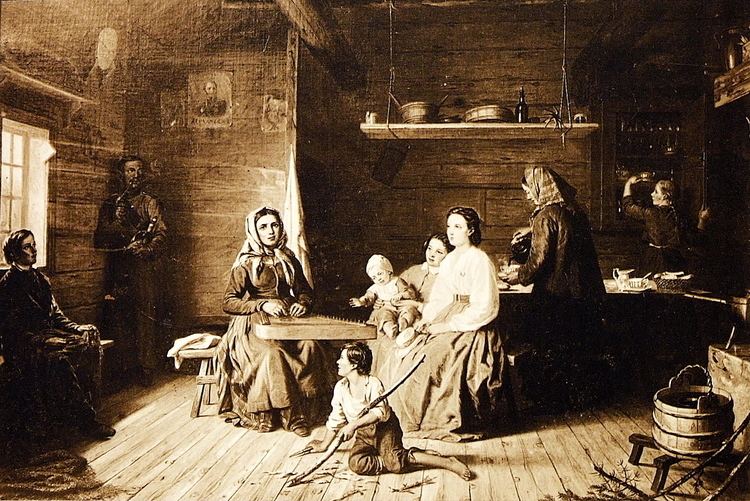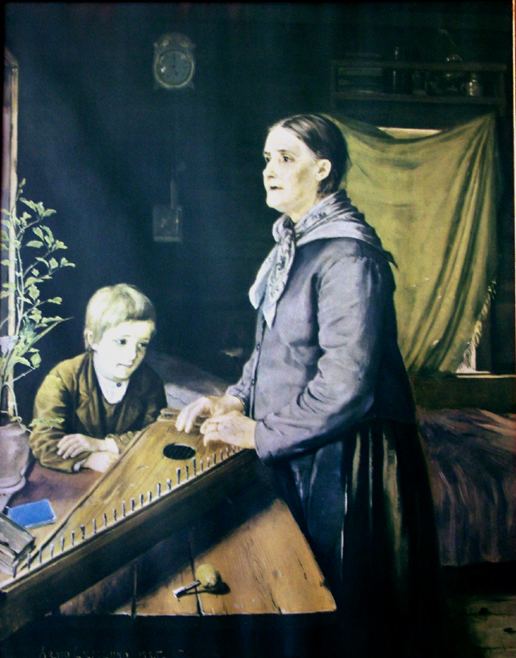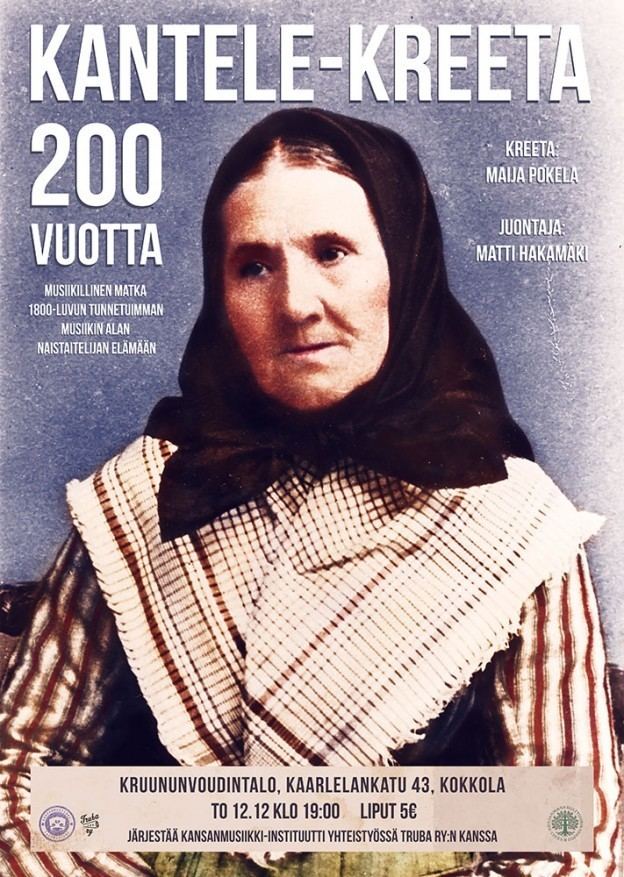Name Kreeta Haapasalo | Role Singer | |
 | ||
Similar People Pekka Hannikainen, Ilmari Hannikainen, Armas Maasalo, Taneli Kuusisto, Kari Tikka | ||
Kanteleeni (säveltäjä: Kreeta Haapasalo)
Kreeta Haapasalo, or Kantele-Kreeta (13 November 1813 - 29 March 1893), was a Finnish kantele-player, singer and folk musician.
Contents

Early life

Kreeta Järvilä was born 13 November 1813 in Kaustby parish in Järvilä village as the youngest of a family of five. Her parents were known as Jaakko Matinpoika Järvilä and Liisa Eliasentytär Björn (Jacob Mattsson Järvilä and Elisabet Eliasdotter Björn). Her mother's father was a soldier with a talent for music: Elias Mattsson Björn.
Kreeta's musical training began at six years of age with a 6-stringed kantele under the guidance of her uncle Vanhatalo Juho (Gammalgården), who played both violin and a "large, black kantele". As a child, she would sit and listen as he played his kantele. She also played the violin in the beginning but quit later. When she became older, her brother made her a bigger instrument of alder with wooden screws.
As a 13-year-old Kreeta moved in with her sister and husband where she helped with the farm work; she stayed with them five years. During this time she became adept at sewing and travelled from house to house sewing. She worked on farms during the summer and did her sewing in the wintertime. As an 18-year-old she moved back to her parents and worked as a seamstress. The young Kreeta's musical interest was concentrated on practicing on the kantele. Nothing was mentioned about Kreeta's singing, but she said in 1890: "When I was young I did not sing, but when sorrow and distress came as an adult, then I first burst out in song."
Kreeta Järvilä was married 24 June 1837 (in full attire with a large crown) to farmer's son Joonas Tanelinpoika Huntus, (Jonas Danielsson Wirkkala), born 13 April 1814 in Kaustby, died 20 May 1890 at Varkaus. The couple had eleven children.
As newlyweds, the young couple stayed in Joonas' home, but after a short time they got a little croft near his parents. They had not settled themselves before they moved to Kreeta's home. After some years they went to Kelviå as crofters. Restlessness led them to a crofter's holding at Haga at Vetil parsonage. They went to Luoma farm the following year, and in 1850 the family moved to Haapasalo, to the side of the village that borders on Halsua, the crown residence. From that time Kreeta began to use the name Haapasalo at the initiative of Zachris Topelius in 1853. The stay at Haapasalo was not of long duration, until they moved back to Haga croft, also to Kritilä croft at the parsonage.
Career as a musician
In 1869 they bought a home at Kalliokoski in Halsua where they stayed four years. The famine of 1867-68 came during this restless period and Kreeta was often forced to go on singing trips. Her husband's inability to work regularly was the biggest cause of the many moves. During these restless and sad times, the following song was born: "Lapseni minun kotia huonolle hoidolle jäi. kun pitkin mailman turuja mun täytyy kulkia näin." (My children left in a corner of the home with poor care while I have to sing and gather my bread from farm to farm.)
She began her appearances in the nearest city of Gamlakarleby in 1853, where one afternoon she received 10 rubles. At one house Captain Langenskjöld encouraged her to give a concert in Helsingfors and gave her a letter of recommendation. She received 275 rubles on her journey through the southern cities; most of the money came in Helsingfors. People showed genuine and pure kindness as Kreeta was so new and overwhelming that from 1853 the media of that time could not be more attentive. People followed her journeys with sympathy and were pleased with her success. In the newspapers of the time one can gather many accounts of the singing and kantele playing at the appearances of the Osterbottniska farmer's wife.
While in Helsingfors, she gave her letters of recommendation to writer and poet Zachris Topelius. When he asked her surname, she replied that she had none. She was known as Kreeta Jacobsdotter, but he felt she should have a surname. The house she was living in at that time was known as Haapasalo, so Topelius advised her to call herself Kreeta Haapasalo. Kantele Kreeta's songs, which she always sang, accompanied her for 40 years in the homes, in schools, at large and small festivals, at concerts, at agricultural shows, at restaurants and at markets.
Johan L. Runeberg arranged a party for her appearance in Borgå. One time she performed at the royal theater in Stockholm. This was arranged by Swedish poet Emil Van Qvanten. She also performed several times in the auditorium of the nobility in Saint Petersburg (Russia).
The family's daughter Fia often followed her mother on trips because she also was a gifted singer and played the kantele. She married at Leppävirta and Kreeta and Joonas with the children Matti and Matilda moved to a rented house in Varkaus. After her husband's death 20 May 1890, Kreeta moved for the last time. Daughter Fia's family moved to Jyväskylä and Kreeta followed. The 80-year-old folk artist's labor ended there with much feeling and inner beauty on 29 Mar 1893. She was buried in the old cemetery in Jyväskylä. In 1899 the Society of Young Finns placed a granite stone on her grave.
Kreeta Haapasalo's extensive repertory was mostly spiritual songs, folk dances, ballads as well as her own songs, which often emphasized sorrow. One time when she returned from a trip she heard that two of her children were to be buried that day. She arrived at the cemetery to hear that an epidemic had taken two of her children.
Court artist R. W. Ekman has immortalized her on three canvases. The most well-known picture of her is one by Arvid Liljelund in Tusby - a painted portrait where Kreeta stands at a window singing and playing and one of her small grandsons sits and listens. Probably all of the older people in Finland know which picture is represented.
Legacy
Aleksis Kivi mentioned her in his poem Anjanpellon markkivat: "Vaimo vakaa Pohjanmaalta soitti kanteleella lempiäll." (The serious woman from Österbotten played her beautiful kantele.)
In 1954 a statue was erected in her memory in Kaustby with Ilmari Wirkkala as a prime sponsor. Another monument was erected at her homeplace in Veteli. In the early 1990s Finland honored her and five other women on postage stamps.
